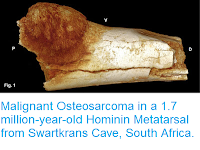The Sterkfontein Caves site, part of the wider ‘Cradle of Humankind’
complex in Gauteng State, South Africa, has yielded the largest known
collection of specimens assigned to the Plio-Pleistocene Hominin species
Australopithecus africanus. The site comprises a series of
karstic caves (i.e. caves created by the action of water percolating
through soft limestone) that would have been encountered by the Hominins
both as cave openings at the surface that could provide potential
shelter and as potholes into which they could fall. Australopithecus africanus specimen Sts 5 is the most complete cranium assigned to the species that has been found in South Africa. It dates from at least 2.1 million years ago, and is probably close to 2.5 million years old. The specimen was discovered in April 1947 by Robert Broom and John Robinson, and identified as a female by Broom, leading to the popular name for this specimen, 'Mrs Ples'. However, since this time a number of other palaeontologists have considered the specimen to be a male.
In a paper published in the South African Journal of Science on 30 January 2018, Gaokgatlhe Tawane of the Ditsong National Museum of Natural History, and Francis Thackeray of the Evolutionary Studies Institute at the University of the Witwatersrand, re-examine specimen Sts 5, with a view to conclusively determining its sex.
Specimen Sts 5 'Mrs Ples' from the collection of the Ditsong National Museum of Natural History. José Braga/
Australopithecus africanus is considered to have been much more sexually dimorphic than Modern Humans, with a marked difference in size between the larger males and the smaller females. Yet such differences are not in themselves reliable determinants of sex, as a small, or young, male can still potentially be smaller than a large female.
Bloom originally considered Sts 5 to be a female based upon the small size of the canine tooth sockets. These today are 7.2 mm by 6.9 mm, which would be considered to be particularly small for a male, lending weight to the idea that the specimen was female. However, the specimen shows signs of acid damage, probably from having been treated with acetic acid at some point during preparation of the specimen. This could potentially eat away the tooth socket, which is essentially a cone shaped hole, so erosion around the outer part will reduce the width of the hole. Tawane and Thackeray consulted Bloom's original data on the skull, and found that he had recorded canine socket diameters of 9 mm and 7.6 mm, larger values which support the idea that the sockets have been shrunk by acid damage, and - importantly - are values that would be considered to be within the male size range today.
In 1999 palaeoanthropologist Charles Lockwood published a paper in which he examined the facial structures of a large number of Australopithecus africanus specimens, with a view to understanding sexual dimorphism in the species. He was unable to assign Sts 5 to a specific sex with any confidence, however he did feel that it was likely to be a male because of its prominent forehead and large eye sockets.
The sex of specimen Sts 5 has long been considered ambivalent due to its mixture of male and female features. Tawane and Thackeray believe that the 'female' features of the specimen can be attributed to poor preparation of the specimen, and therefore conclude that it should be regarded as a male.
See also...
Follow Sciency Thoughts on Facebook.







